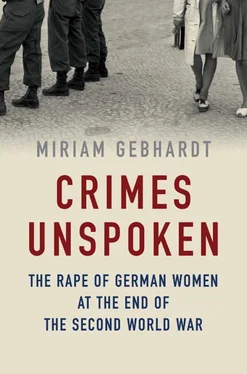Every effort has been made to trace all copyright holders, but if any have been inadvertently overlooked the publisher will be pleased to include any necessary credits in any subsequent reprint or edition.
For further information on Polity, visit our website: politybooks.com
See Atina Grossmann, ‘A Question of Silence: The Rape of German Women by Occupation Soldiers’, in: Robert G. Moeller (ed.), West Germany under Construction: Politics, Society, and Culture in the Adenauer Era (Michigan 1997), pp. 33–52.
Laurel Cohen-Pfister, ‘Rape, War, and Outrage: Changing Perceptions on German Victimhood in the Period of Post-Unification’, in: Cohen-Pfister and Dagmar Weinröder-Skinner (eds.), Victims and Perpetrators: 1933–1945, (Re)Presenting the Past in Post-Unification Culture (Berlin, New York 2006), pp. 316–36, here p. 318.
Jens Bisky, ‘Wenn Jungen Weltgeschichte spielen, haben Mädchen stumme Rollen: Wer war die Anonyma in Berlin? Frauen, Fakten und Fiktionen – Anmerkungen zu einem grossen Bucherfolg dieses Sommers’ in: Süddeutsche Zeitung , 24 September 2003, p. 16.
Martina Böhmer, Erfahrungen sexualisierter Gewalt in der Lebensgeschichte alter Frauen: Ansätze für eine frauenorientierte Altenarbeit (Frankfurt 2011).
Rudolf Albart, Die letzten und die ersten Tage: Bambergs Kriegstagebuch 1944/46 (Bamberg 1953), p. 91.
Dieter Hildebrandt and Felix Kuballa (eds.), Mein Kriegsende: Erinnerungen an die Stunde Null (Berlin 2012), p. 221.
The subject of sexual aggression by the German Wehrmacht has been studied increasingly in recent years. One of the latest articles is Regina Mühlhäuser, ‘Eine Frage der Ehre: Anmerkungen zur Sexualität deutscher Soldaten während des Zweiten Weltkriegs’, in: Wolfgang Bialas and Lothar Fritze (eds.), Ideologie und Moral im Nationalsozialismus (Göttingen 2014), pp. 153–74.
In the former local cemetery in Neukölln is a hidden memorial stone with the inscription: ‘Against war and violence. In memory of the victims of expulsion, deportation, rape and slave labour. Innocent children and mothers, women and young girls. Their suffering in the turmoil of the Second World War should not be forgotten, so as to prevent future suffering.’ Information on the feminist women’s rights organization at www.medicamondiale.org.
Frank Biess, ‘Moral Panic in Postwar Germany: The Abduction of Young Germans into the Foreign Legion and French Colonialism in the 1950s’, in: Journal of Modern History 84, 4 (2012), 789–832.
Walter Ziegler, ‘Bayern im Übergang: Vom Kriegsende zur Besatzung 1945’, in: Peter Pfister (ed.), Das Ende des Zweiten Weltkriegs im Erzbistum München und Freising (Regensburg 2005), pp. 33–104, here p. 102.
Robert G. Moeller, ‘Deutsche Opfer, Opfer der Deutschen: Kriegsgefangene, Vertriebene, NS-Verfolgte – Opferausgleich also Indentitätspolitik’, in: Klaus Naumann (ed.), Nachkrieg in Deutschland (Hamburg 2001), pp. 29–58, here p. 32.
Biess, ‘Moral Panic’, pp. 792–3.
See Ruth Seifert, ‘Krieg und Vergewaltigung: Ansätze zu einer Analyse’, Working Paper (Munich 1993), p. 19.
An early interest in the fatherless male generation was shown at a congress in April 2005 in Frankfurt. See Lu Seegers, ‘Die Generation der Kriegskinder und ihre Botschaft für Europa sechzig Jahre nach Kriegsende’, in: H-Soz-u-Kult , 1 May 2005. Other studies from the male point of view followed, e.g. Hermann Schulz, Harmut Radebold and Jürgen Reulecke, Söhne ohne Väter: Erfahrungen der Kriegsgeneration (Berlin 2004). The cover shows a boy in the Nazi era with a model aeroplane in his hand and a mother figure in the background.
Burkhard Asmuss (ed.), 1945 – Der Krieg und seine Folgen , book accompanying the exhibition ‘Kriegsende und Vergangenheitspolitik in Deutschland’ (Berlin 2005).
The research group led by Philipp Kuwert has studied the psychotraumatic consequences, above all of victims of rape by Red Army soldiers. Its findings are published in Svenja Eichhorn and Philipp Kuwert, Das Geheimnis unserer Grossmütter: Eine empirische Studie über sexualisierte Kriegsgewalt um 1945 (Giessen 2011).
The occupation statute was in force from September 1949 until the Paris Agreements of May 1955 and determined the legal authority and responsibilities of the Western powers in the Federal Republic. The rights of the Allies did not end until the reunification and the Two Plus Four Treaty of March 1991, which restored the Federal Republic’s full sovereignty.
See the archive items not seen by me in the Hamburg State Archive under 354–5 II (Jugendbehörde II) no. 240 Uneheliche Kinder von Besatzungssoldaten; 354–5 II (Jugendbehörde II) no. 239 Vormundschaft für Kinder aus Vergewaltigungen durch Angehörige der Besatzungsmächte; 131–1 II (Senatskanzlei) no. 2810 Übergriffe von Angehörigen der Besatzungsmacht 1946–1965; 131–11 (Personalamt) no. 1697 Schadensersatzansprüche gegen die Besatzungsmacht 1946–1952; 131–5 (Senatskanzlei – Verwaltungsbeschwerden) no. 234 Besatzungsschäden durch Straftaten britischer Soldaten 1949; 132–5/11 (Hamburgische Ver-tretung beim Bund in Bonn) no. A391 Unterhaltsverpflichtungen für uneheliche Kinder von Besatzungsangehörigen 1950–1953.
The American and Soviet occupied zones comprised 17.2 million citizens in 1946, the British 22 million, and the French 5 million.
Willy Klapproth, Kriegschronik 1945 der Stadt Soltau und Umgebung, mit Beiträgen zur Kriegsgeschichte 1945 der Süd- und Mittelheide (Soltau 1955), p. 205.
Clive Emsley, Solder, Sailor, Beggarman, Thief: Crime and the British Armed Services since 1914 (Oxford 2013), pp. 128–30, 131.
On the changing role of the US Army, see Hans Joachim Harder, ‘Guarantors of Peace and Freedom: The US Forces in Germany, 1945–1990’, in: Thomas Maulucci and Detlev Junker (eds.), GIs in Germany: The Social, Economic, Cultural, and Political History of the American Military Presence (Cambridge 2013), pp. 37–54. On the crime rate of GIs, see Gerhard Fürmetz, ‘Insolent Occupiers, Aggressive Protectors’, in: Maulucci and Junker (eds.), GIs in Germany , pp. 189–211.
Rainer Schulze, ‘A Difficult Interlude: Relations between British Military Government and the German Population and their Effects for the Constitution of a Democratic Society’, in: Alan Bance (ed.), The Cultural Legacy of the British Occupation in Germany: The London Symposium (Stuttgart 1997), pp. 67–109.
I retain the term ‘sexual aggression’. All other forms of ‘sexualized aggression’ were not perceived as such at the time. I also believe for political reasons that an understandable everyday expression is more important than academically differentiated objectivization, which risks excluding the people concerned.
The figures for Austria also fluctuate considerably. According to contemporary sources, there were between 70,000 and 100,000 cases in Vienna; see Barbara Stelzl-Marx, Stalins Soldaten in Österreich: Die Innensicht der sowjetischen Besatzung 1945–1955 (Vienna 2012), p. 411.
Читать дальше











